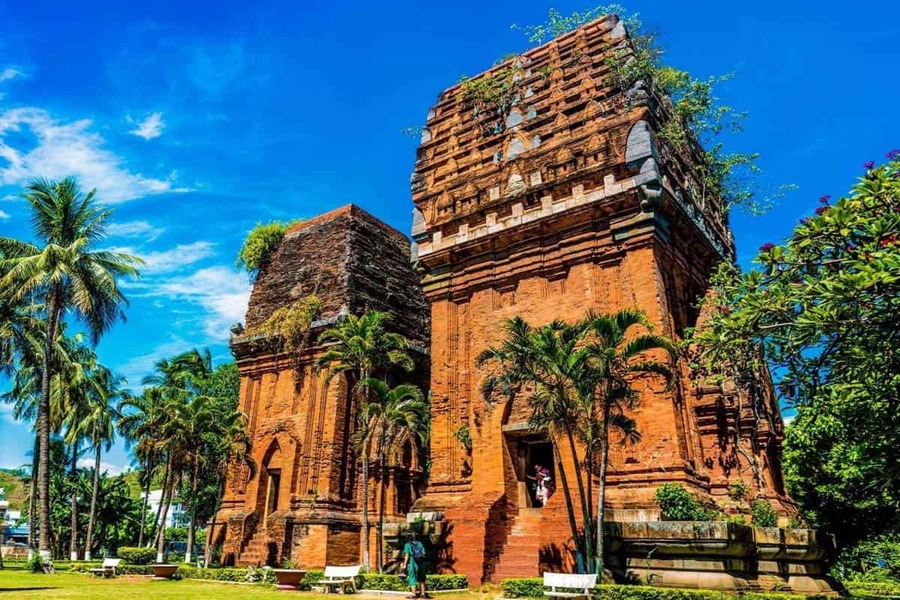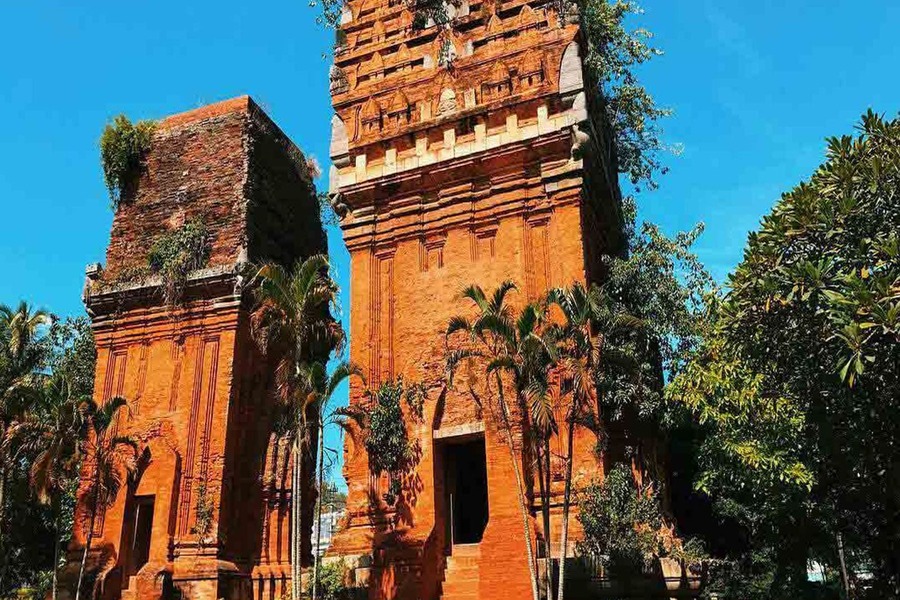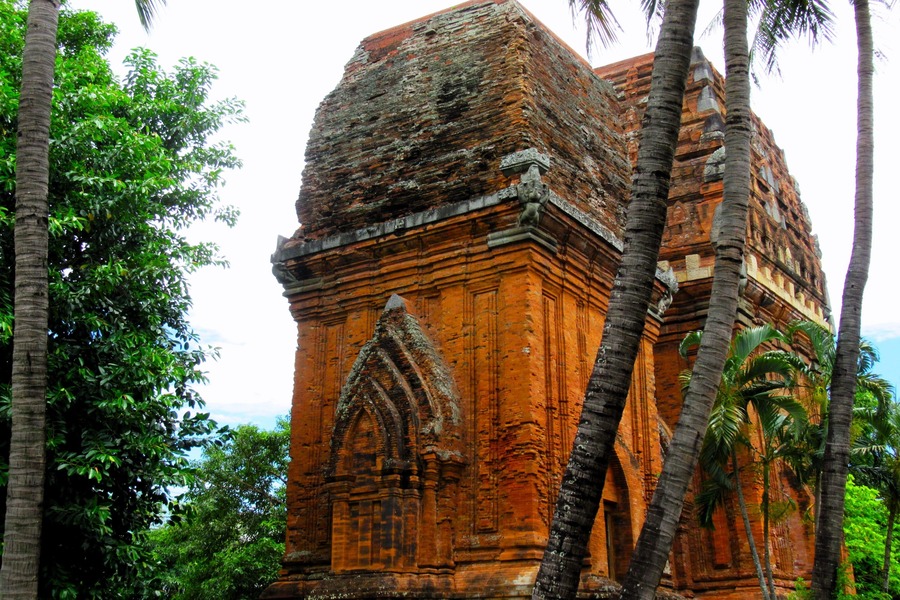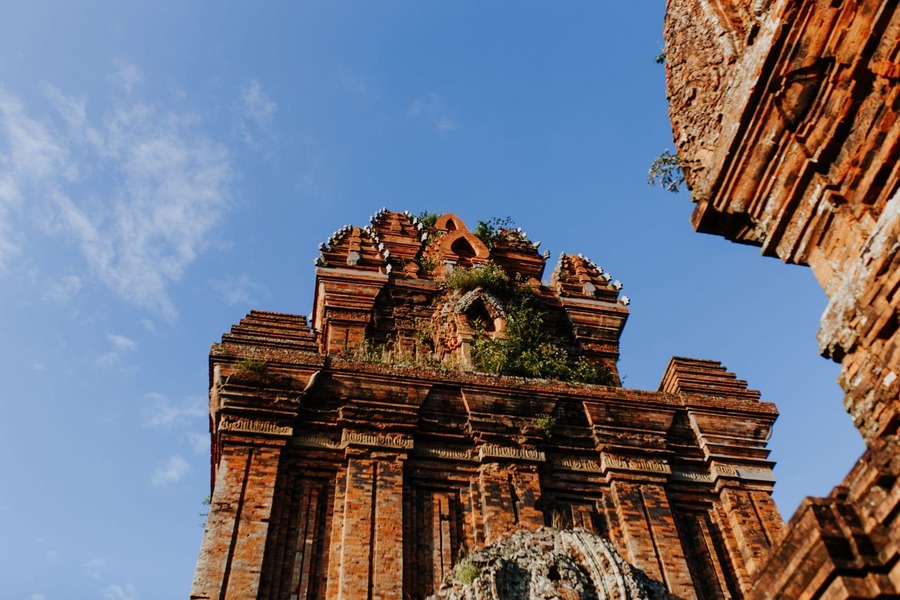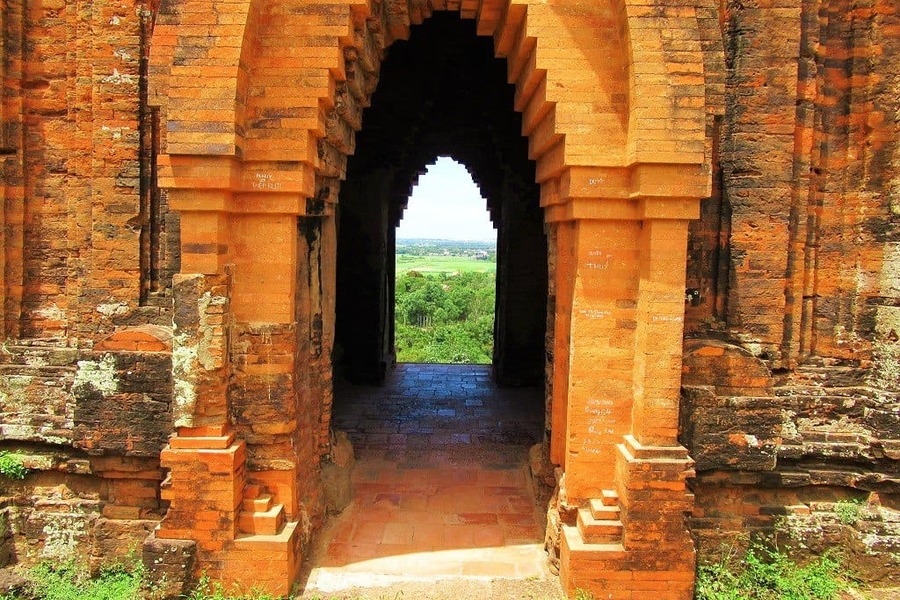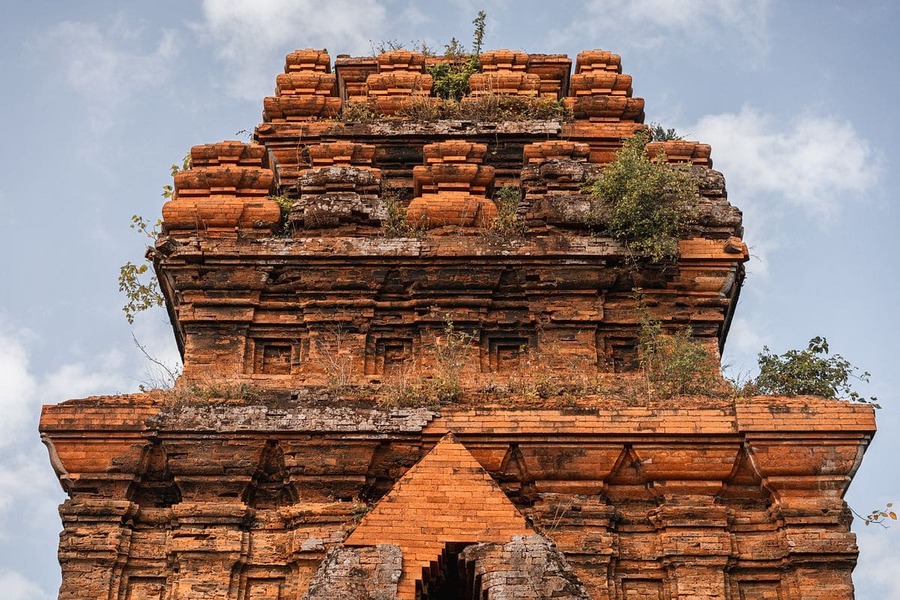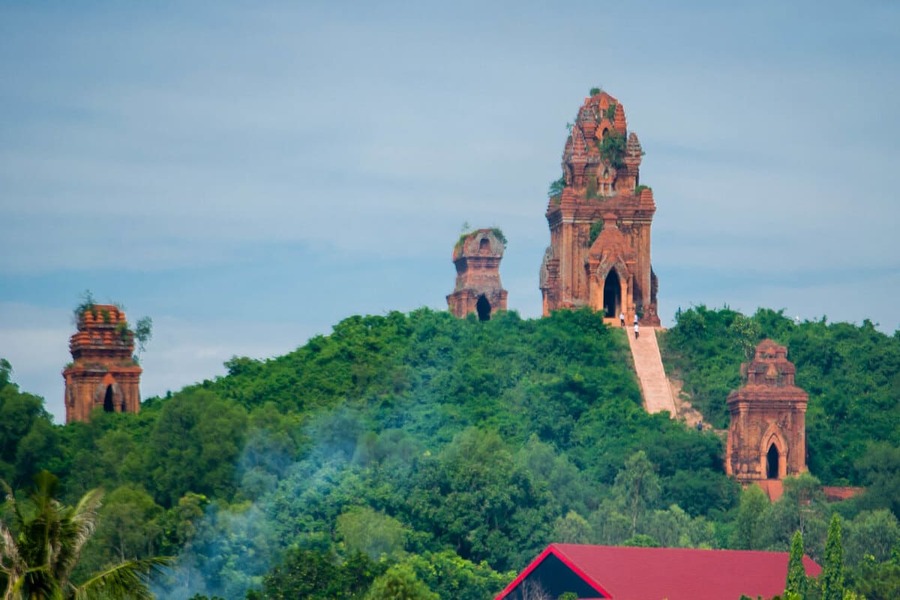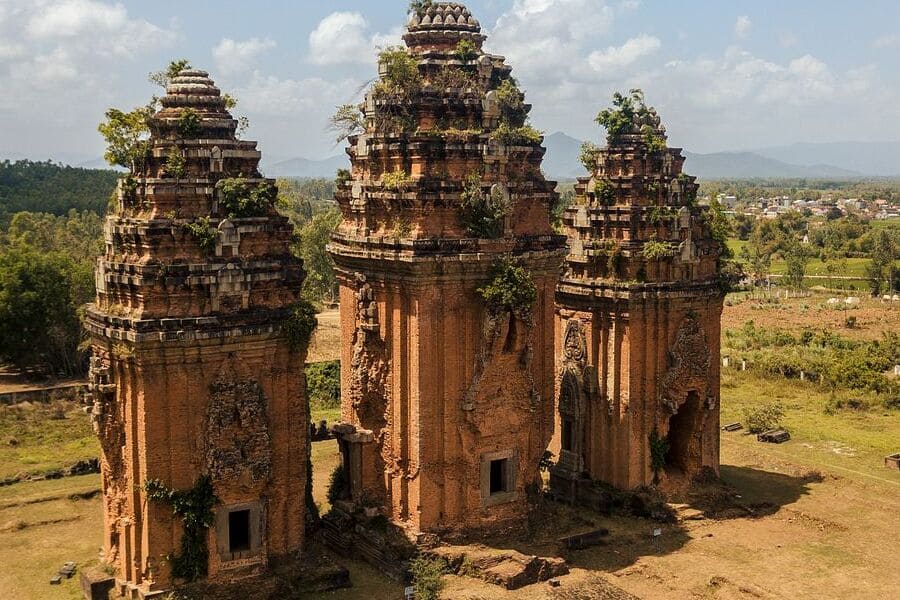Visitors to the Twin Cham Towers can explore the stunning artistry of Cham architecture, with detailed stone carvings depicting elephants, lions, and dancers, and four giant Garuda birds adorning the corners. The towers’ cultural and religious significance is profound, having served as important sites for worship and community rituals in the predominantly Hindu Cham society. Nestled amidst lush coconut palms and banana gardens, the site offers a tranquil escape from the bustling city, providing a serene environment to appreciate the historical and spiritual essence of the Cham civilization. The trip to Twin Cham Towers In Quy Nhon would leave you with a lot of impressions and definitely a mark on your Vietnam shore excursions.
About Twin Cham Towers in Quy Nhon
Twin Cham Towers (Thap Doi Towers), located in Quy Nhon, Binh Dinh, Viet Nam, the ancient capital of the Cham people, is one of the most accessible and representative examples of Cham architecture in Vietnam. For an entrance fee of VND 10,000, visitors can explore these towers situated approximately 3 km northwest of the city center. Built centuries ago, the Twin Cham Towers stand as a significant symbol of Vietnam’s cultural heritage. True to its name, the site features two towers standing side by side, resembling a couple in their architectural symmetry.
The architecture of the Twin Cham Towers reflects the distinctive cultural traits of the Cham people, infused with influences from Hindu art. Visitors can admire the towers’ typical Cham design elements, offering insights into Vietnam’s rich historical past. The site also provides excellent opportunities for photography, capturing the intricate details of the towers against the backdrop of lush coconut palms and banana gardens. It serves as a tranquil retreat from the bustling city of Quy Nhon, inviting visitors to enjoy moments of peace and contemplation amidst its serene surroundings.
History of Twin Cham Towers
Your Quy Nhon shore excursions would be much more meaningful and mind-opening once you delve into the interesting historical story of the Twin Cham Towers. The Twin Cham Towers, built between the 10th and 15th centuries, stand as enduring testaments to the rich cultural exchange between the Champa civilization and the Khmer Empire. These towers, characterized by intricate carvings and distinctive architectural features, reflect the historical and artistic influences of their time.
Over the centuries, the Twin Cham Towers endured the ravages of numerous wars in Vietnam, resulting in significant damage and deterioration. However, in 1991, recognizing their cultural and architectural importance, authorities undertook a restoration effort to preserve these iconic structures. The restoration aimed to return the towers to their original appearance, showcasing the Cham culture and architectural style to visitors.
Situated on a spacious plain at the foot of a hill, facing southward, the Twin Cham Towers exhibit similar square-shaped structures and curved roofs. Notably, the Northern tower rises higher than its Southern counterpart, adding a distinctive asymmetry to their symmetrical design.
Legend surrounds Cham towers, often comprising three structures. However, the Twin Cham Towers defy this convention, consisting of only two towers due to the cancellation of the construction of a third tower before it began. This historical anomaly adds to the allure and mystique of these ancient edifices, inviting visitors to explore their rich cultural heritage and architectural marvels.
Architecture of Twin Cham Towers
The Twin Cham Towers, while not conforming to the traditional multi-story square tower design typical of Cham architecture, exhibit a unique blend of Cham and Khmer influences. Each tower comprises two distinct parts: a square base and blocky curved tops, reminiscent of Khmer temple architecture seen in Angkor Wat. Adorning the walls are intricately carved depictions of deity animals such as birds and other creatures significant in Cham religious symbolism. Scholars believe that the images of holy birds with raised open arms in the tower corners reflect the influence of Khmer art during the 12th and 13th centuries, yet the overall shape, structure, and decoration remain distinctly Cham.
The Northern tower’s base, constructed from large sandstone blocks, resembles a colossal lotus supporting the entire structure. Each sandstone block features beautifully carved images of elephants, lions, and dancers, showcasing the craftsmanship of Cham artisans. Like many Cham towers, the Northern tower boasts a projecting roof designed to create an expansive eave. Under Khmer artistic influence, the stone eave is adorned with depictions of dancing monkeys, lion and elephant heads, and human figures with multiple arms, adding to its ornate beauty. At the tower’s four corners stand imposing stone Garuda birds, carved in the Khmer style, further emphasizing its cultural synthesis.
Though less well-preserved than the Northern tower, the Southern tower’s stone base exhibits a similar architectural style and aesthetic. The carved paintings atop the tower and the artificial doors bear resemblance to those found in its counterpart, suggesting a harmonious architectural continuity between the two structures. Together, the Twin Cham Towers stand as enduring symbols of cultural exchange and architectural excellence, blending Cham and Khmer influences in a distinctive and captivating manner.
Twin Cham Towers’s Cultural and Religious Significance
The Twin Cham Towers, located in Quy Nhon, hold significant cultural and religious importance that reflects the rich heritage of the Cham people and their interactions with neighboring civilizations. As prime examples of Cham architecture, the towers showcase unique building techniques and artistic styles, featuring intricate carvings of deity animals, religious symbols, and mythical creatures that highlight the advanced level of craftsmanship and aesthetic values of the Cham civilization. Built between the 10th and 15th centuries, the towers embody a period of significant cultural exchange between the Champa Kingdom and the Khmer Empire. This exchange is evident in the architectural style, which combines traditional Cham elements with influences from Khmer temples, particularly visible in the blocky curved tops and detailed carvings. The Twin Cham Towers also serve as a testament to the spiritual life of the Cham people, who were predominantly Hindu. The towers were likely used for religious ceremonies and rituals, making them important centers for worship and community gatherings. Their historical and cultural significance has been recognized through restoration efforts, ensuring that these monuments continue to represent the rich cultural tapestry of Vietnam and the enduring legacy of the Cham people.
What to do when visiting Twin Cham Towers?
When visiting the Twin Cham Towers in Quy Nhon, there are several activities and experiences to make your trip memorable:
- Explore the Architecture: Admire the unique architecture of the Twin Cham Towers, which combines Cham cultural features with Hindu art influences. Note the intricate carvings of deity animals and religious symbols on the towers.
- Learn the History: Delve into the rich history of the Cham people and their interactions with neighboring cultures, such as the Khmer Empire. Understanding the historical context adds depth to your visit.
- Take Photos: Capture the beauty of the towers and their surroundings. The lush coconut palms and banana gardens provide a serene and picturesque backdrop for photography.
- Enjoy the Scenery: Take in the peaceful ambiance of the area. The towers are located in a tranquil setting away from the hustle and bustle of Quy Nhon city, making it a perfect spot to relax and enjoy nature.
- Visit Nearby Attractions: Combine your visit to the Twin Cham Towers with a trip to other nearby attractions, such as the Banh It Towers, Vijaya Citadel, and Duong Long Tower, to gain a more comprehensive understanding of Cham architecture and history.
- Cultural Appreciation: Observe and appreciate the cultural significance of the towers. The site is a living testament to the artistic and architectural achievements of the Cham civilization.
- Local Interaction: Engage with local guides or residents who can provide additional insights and stories about the towers and the Cham culture. This can enrich your experience and understanding of the site.
- Meditation and Reflection: Use the serene environment to meditate or reflect. The spiritual ambiance of the site can offer a perfect opportunity for personal introspection and relaxation.
- Picnic: Enjoy a picnic in the scenic surroundings. The peaceful environment is ideal for a leisurely meal amidst nature.
By engaging in these activities, you can fully appreciate the historical, cultural, and natural beauty of the Twin Cham Towers and their significance in Vietnam’s heritage.
Other Cham Towers in Quy Nhon Worth a Visit
Banh It Towers
Location: Dai Loc village, Phuoc Hiep commune, Tuy Phuoc district, Binh Dinh province
Banh It Towers offer a panoramic view of Thi Nai River, Truong Son mountains, and the ocean. These towers are known for their unique architectural style and intricate carvings, showcasing the craftsmanship of the Cham people. Visitors can explore the historical significance of the site while enjoying breathtaking natural scenery.
Vijaya Citadel
Location: Nam An village, Nhon Hau commune, An Nhon district, Binh Dinh province
Vijaya Citadel is steeped in historical significance, bearing witness to momentous shifts and bloody battles in Vietnamese history. Originally built as a stronghold by the Champa kingdom, it later became a pivotal site in conflicts between local powers. Visitors can delve into the citadel’s rich past and appreciate its strategic importance through guided tours and exhibits.
Duong Long Tower
Location: Van Tuong village, Binh Hoa commune, Tay Son district, Binh Dinh province
Duong Long Tower is renowned for its abundant stonework and serves as an important ritual site. The tower’s architecture reflects the spiritual and cultural practices of the Cham people, with intricate carvings and symbolic motifs adorning its structure. It stands as a testament to the religious beliefs and ceremonial practices of the Cham civilization.
These towers not only showcase the architectural prowess of the Cham people but also provide insights into their cultural heritage and historical significance in the region. Each site offers a unique experience, from panoramic views and natural beauty to profound historical narratives and spiritual exploration.
How to get to Twin Cham Towers from Quy Nhon city center
To reach the Twin Cham Towers from Quy Nhon city center, you have a few options depending on your preference and convenience:
- Taxi: Taking a taxi is one of the easiest ways to get to the Twin Cham Towers. Taxis are readily available in Quy Nhon city center, and you can simply hail one or ask your accommodation to arrange a taxi for you. The ride to the towers should take around 10-15 minutes depending on traffic, and taxi fares are generally affordable in Vietnam. Make sure to negotiate the fare or ensure the meter is used before starting the journey.
- Motorbike: Renting a motorbike is a popular option for travelers who prefer flexibility and independence. Many rental shops in Quy Nhon offer motorbikes for daily or hourly rates. Riding a motorbike to the Twin Cham Towers allows you to enjoy the scenic route and explore at your own pace. The distance from Quy Nhon city center to the towers is approximately 3 km, so it’s a short ride that takes around 10 minutes. Always wear a helmet and follow traffic rules for safety.
- Bicycle: For those who enjoy cycling, you can rent a bicycle in Quy Nhon and ride to the Twin Cham Towers. This option provides a leisurely way to explore the city and its surroundings while enjoying the fresh air. The ride may take a bit longer compared to a motorbike or taxi, but it’s a great way to immerse yourself in the local atmosphere.
- Walking: If you enjoy walking and the weather permits, you can walk to the Twin Cham Towers from Quy Nhon city center. It’s about 3 km, so it would take around 30-40 minutes depending on your pace. Walking allows you to take in the sights and sounds of the city along the way, and you can explore the nearby neighborhoods.
Whichever mode of transportation you choose, visiting the Twin Cham Towers from Quy Nhon city center is convenient and offers a glimpse into the rich cultural heritage of the Cham people in Vietnam.

